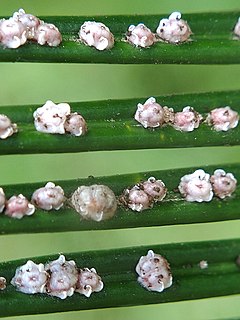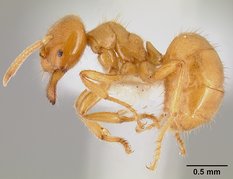Related Research Articles

Mealybugs are insects in the family Pseudococcidae, unarmored scale insects found in moist, warm habitats. Many species are considered pests as they feed on plant juices of greenhouse plants, house plants and subtropical trees and also act as a vector for several plant diseases. Some ants, however live in symbiotic relationships with them.

Scale insects are small insects of the order Hemiptera, suborder Sternorrhyncha. Of dramatically variable appearance and extreme sexual dimorphism, they comprise the superfamily Coccoidea. Adult females typically have soft bodies and no limbs, and are concealed underneath domed scales, extruding quantities of wax for protection. Some species are hermaphroditic, with a combined ovotestis instead of separate ovaries and testes. Males, in the species where they occur, have legs and sometimes wings, and resemble small flies. Scale insects are herbivores, piercing plant tissues with their mouthparts and remaining in one place, feeding on sap. The excess fluid they imbibe is secreted as honeydew on which sooty mold tends to grow. The insects often have a mutualistic relationship with ants, which feed on the honeydew and protect them from predators. There are about 8,000 described species.

Harpegnathos saltator, sometimes called the Indian jumping ant or Jerdon's jumping ant, is a species of ant found in India. They have long mandibles and have the ability to leap a few inches. They are large-eyed and active predators that hunt mainly in the early morning. The colonies are small and the difference between workers and queens is very slight.

Solenopsis molesta is the best known species of Solenopsisthief ants. They get their names from their habit of nesting close to other ant nests, from which they steal food. They are also called grease ants because they are attracted to grease. Nuptial flight in this species occur from late July through early fall.

Trophobiosis is a symbiotic association between organisms where food is obtained or provided. The provider of food in the association is referred to as a trophobiont. The name is derived from the Greek τροφή trophē, meaning "nourishment" and -βίωσις -biosis which is short for the English symbiosis.

Acropyga is a genus of small formicine ants. Some species can be indirect pests. A. acutiventris, which is found from India to Australia, tends subterranean, root-feeding mealybugs of the species Xenococcus annandalei. Living, gravid females are carried in the jaws of A. acutiventris queens during their nuptial flight, to establish the symbiotic association in founding colonies. Other Acropyga species have relationships with different species of mealybugs, and it could be a trait common to the whole genus.

Technomyrmex albipes, commonly known as the white-footed ant, is a species of ant first described in 1861 from Sulawesi, Indonesia by the British entomologist Frederick Smith. Invasive pest ants in Florida, previously identified as T. albipes, have now been separated as Technomyrmex difficilis, both forming part of a species complex with a worldwide distribution.

Acromyrmex is a genus of New World ants of the subfamily Myrmicinae. This genus is found in South America and parts of Central America and the Caribbean Islands, and contains 31 known species. Commonly known as "leafcutter ants" they comprise one of the two genera of advanced attines within the tribe Attini, along with Atta.

Pheidole megacephala is a species of ant in the family Formicidae. It is commonly known as the big-headed ant in the USA and the coastal brown ant in Australia. It is a very successful invasive species and is considered a danger to native ants in Australia and other places. It has been nominated as one of the hundred "World's worst" invaders.

Electromyrmococcus is an extinct genus of mealybug in the Pseudococcidae subfamily Rhizoecinae. The genus currently contains three species, all from the early Miocene, Burdigalian stage, Dominican amber deposits on the island of Hispaniola.
Newsteadia myersi is the only member of the scale insect family Ortheziidae to have been found in New Zealand. It was found by sifting through the leaf litter and debris under nikau palm trees.

Acropyga acutiventris is an ant in the subfamily Formicinae. It lives underground in tropical regions and forms a mutualistic association with the mealybug, Xenococcus annandalei.

Doleromyrma darwiniana is a species of ant in the genus Doleromyrma. Described by Forel in 1907, the species is endemic to Australia and introduced to New Zealand, and it nests in soil or under stones and logs. The organism grows to a length between 2.0 and 3.0 millimeters. This species of ant maintains small colony sizes and it "prefers protein food." The species is also known by some sources as the "brown house ant" and "Darwin's ant". The species is considered a "minor urban pest" in New South Wales.

Planococcus citri, commonly known as the citrus mealybug, is a species of mealybugs native to Asia. It has been introduced to the rest of the world, including Europe, the Americas, and Oceania, as an agricultural pest. It is associated with citrus, but it attacks a wide range of crop plants, ornamental plants, and wild flora.

Trichomyrmex destructor is a species of ant in the subfamily Myrmicinae. Its common names include destructive trailing ant or Singapore ant. It is a pest species in urban areas, known for causing costly damage to structures, vehicles, and electronic devices with its chewing activity. In 2015, the species was moved from the genus Monomorium to the revised genus Trichomyrmex.

Acropyga epedana is an ant in the subfamily Formicinae. It lives permanently underground in the Chiricahua Mountains in Arizona and forms a mutualistic association with the mealybug Rhizoecus colombiensis.
Balanococcus cordylinidis, the cabbage tree mealybug, is a species of insect in the family Pseudococcidae.

Phenacoccus solenopsis, the cotton mealybug or solenopsis mealybug, is a species of mealybug in the family Pseudococcidae. Having originated in North America, it has spread to other parts of the world and become a major pest of cotton crops.
Acropyga exsanguis is a species of ant in the subfamily Formicinae. It lives in underground nests in Mexico, Central and South America.
Geococcus coffeae is a species in the mealybug family, Pseudococcidae, commonly known as the coffee root mealybug, or brown scale. It lives underground where it inserts its mouthparts into roots and sucks the sap.
References
- 1 2 3 The anomalous ant-attended mealybugs of south-east Asia
- 1 2 3 Scale Net Archived August 26, 2011, at the Wayback Machine
- 1 2 Nomenclature and distribution of some Australian and New Guinean ants of the subfamily Formicinae Archived March 3, 2016, at the Wayback Machine
- ↑ Acropyga